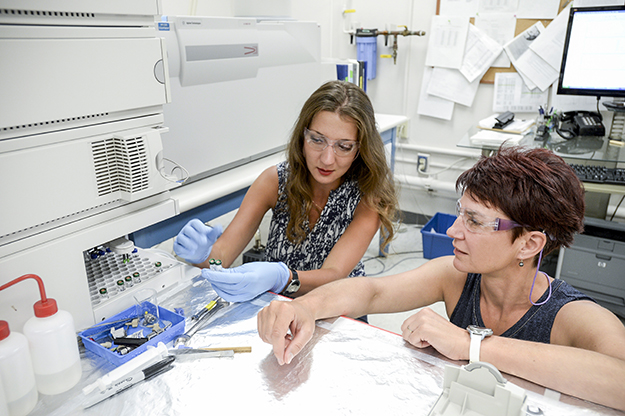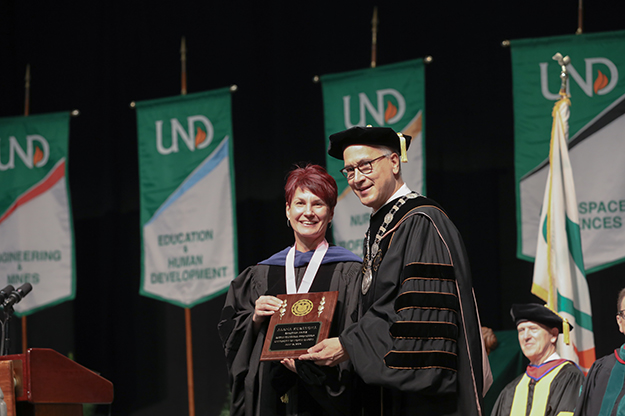Chemistry all around
Next UND Faculty Lecture features Alena Kubatova and the ubiquity of science in everyday life

What is the difference between methanol and ethanol?
Contained in alcoholic beverages, the latter can easily rouse your spirit. The former, however, can leave you blind.
This vast divergence in the effects of methanol and ethanol on the human body stems from a single carbon that defines their compositions.
“One carbon difference and what it does,” said Alena Kubatova, Chester Fritz Distinguished Professor in chemistry, teasing the lead of her Faculty Lecture Series presentation, which is set for 4:30 p.m., Wedneday (Jan. 23) in the Memorial Union Lecture Bowl. A social precedes the lecture at 4 p.m.
Such a minuscule dissimilarity with enormous consequences may sound frightening. But, it also underscores the crucial – yet not always conspicuous – role chemistry wields in everyday life. It is in the food we consume, the garments we don.
“Most people see chemistry as something dangerous and scary but they do not see all the functional uses of chemistry,” said Kubatova.
With her lecture, she hopes to correct that perception.
She wants to expose attendants to the array of extraordinary applications of chemical research and analysis.
Slivers of it have even starred in Hollywood. Flicks like Bones, Forensic Files and the CSI franchise showcase – albeit in a cursory and simplified manner – the type of work Kubatova loves.
“When you see all these movies, when they show forensic science investigation, they always show glimpses of very similar data I work with,” she said.
Hence the title of her talk – Chemical Analysis as CSI Investigation: From Biofuels to Atmospheric Particles.

What we burn
Biofuel research earned Kubatova a patent for her collaboration with chemical engineer and fellow Chester Fritz Distinguished Professor Wayne Seames and Brian Tande, also a talented UND chemical engineer, on the conversion of soybeans and canola into sources of energy.
Approaching experiments as an analytical chemist, she discovered a high percentage of biofuel acids – previously not suspected – that could spur adverse impacts like engine corrosion.
“There are other markets for such acids,” Kubatova said. “They can be used for the generation of other materials. Our work exemplifies the value of thorough analysis to detect evasive chemical components.”
Kubatova and her co-researchers developed a method to extract the acids. Etched on a gold plague, the patent for it now hangs above her office door.
The achievement heaped one more known into the mound of human cognizance. Yet, the abyss of unknown remains immense, Kubatova said.
What we breathe
Air fills part of it. The concoction of gasses enshrouding our planet is so vital and ubiquitous to our existence that most of us do not even ponder over it. But Kubatova does.
“We try to forecast weather, climate change and yet we do not know half of the chemicals, which are in the air,” said Kubatova. “If you are missing something important, it’s like being blind, because you just don’t know what you are missing.”
Focused on effectively characterizing air particles, Kubatova strives to dispel various dark patches.
Without any major local contaminators and with often persistent wind, the air in Grand Forks is fairly clean, which makes it both a bane and a boon for her research.
Because of its purity, the air in the area permits the study of the long-haul flows of distant pollutants such as the Canadian wild fires that raged over the past summer and heaved smoke plumes across the border.
Closer to home, Kubatova is looking to probe the atmospheric impact of harvest.
“It does not matter whether it is positive or negative,” she said. “It is important how and which chemicals come up from the soil or from plants.”
To decipher this, Kubatova is to team up with UND atmospheric scientists. They grasp air movements. She brings in chemical expertise.
“It is not one discipline that can solve it all,” she said.
Scientific cooperation
If there was another message Kubatova would like to convey in the upcoming high-profile lecture – aside from the utility of chemistry – that would be it.
Scientific cooperation boasts the potential to efface existential worries, she said.
“You need to split that worrying about important aspects of our lives among the people who have training in disparate fields,” Kubatova said.
As for her, she worries about air and biofuels, among other topics, and, mostly, about translating chemistry into lay terms. After all, it is a part of life.


